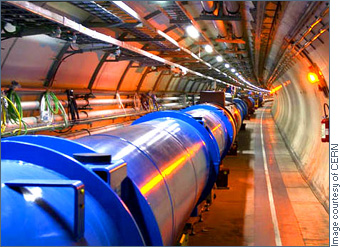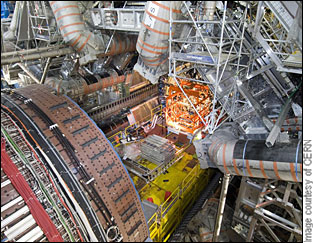U.S. Scientists Count Down to LHC Startup
August 7, 2008
Batavia, IL, Berkeley, CA and Upton, NY – On September 10, scientists at the Large Hadron Collider will attempt for the first time to send a proton beam zooming around the 27-kilometer-long accelerator. The LHC, the world’s most powerful particle accelerator, is located at CERN in Geneva, Switzerland. Journalists are invited to attend LHC first beam events at CERN and several locations within the United States. Information about the CERN event and accreditation procedures is available at www.cern.ch/lhc-first-beam. A list of LHC startup events in the U.S. and contact information for each is available at www.uslhc.us/first_beam.

The LHC tunnel
About 150 scientists from three U.S. Department of Energy Office of Science National Laboratories - Brookhaven National Laboratory on Long Island, Fermi National Accelerator Laboratory in Illinois and Lawrence Berkeley National Laboratory in California - have built crucial LHC accelerator components. They are joined by colleagues from the Stanford Linear Accelerator Center and the University of Texas at Austin in commissioning and continuing R&D for the LHC.
United States contributions to the Large Hadron Collider are supported by the U.S. Department of Energy Office of Science and the National Science Foundation.
The LHC will go for a test drive this weekend, when the first particles are injected into a small section of the LHC. The LHC is the final step in a series of accelerators that bring beam particles from a standstill to energies of 7 TeV. In the injection test this weekend, scientists will make the first attempt to send protons into the LHC, steering them around approximately one-eighth of the LHC ring before safely disposing of the low-intensity beam.
Next up is a series of tests to confirm that the entire LHC machine is capable of accelerating beams to an energy of 5 TeV, the target energy for 2008. On September 10, LHC scientists will go full throttle and try for the first circulating beam. First collisions of protons in the center of the LHC experiments are expected four to eight weeks later.

Brookhaven National Laboratory led the development of the 32 muon detectors in the LHC's ATLAS detector, above.
“We’re finishing a marathon with a sprint,” said CERN’s Lyn Evans, the LHC project leader. “It’s been a long haul, and we’re all eager to get the LHC research program underway.”
About 1,600 scientists from 93 U.S. institutions participate in the LHC experiments, which will analyze the LHC’s high-energy collisions in search of extraordinary discoveries about the nature of the physical universe. The LHC experiments could reveal the origins of mass, shed light on dark matter, uncover hidden symmetries of the universe and possibly find extra dimensions of space.
U.S. first beam events will take place at Fermilab near Chicago, Illinois, Brookhaven Lab in Upton, New York, and in the San Francisco Bay area. More information is available at www.uslhc.us/first_beam.
Media contacts
Brookhaven National Laboratory – Kendra Snyder, ksnyder@bnl.gov, 631-344-8191
Fermilab – Judy Jackson, jjackson@fnal.gov, 630-840-3351
Lawrence Berkeley National Laboratory – Dan Krotz, dakrotz@lbl.gov, (510) 486-4019 and Paul Preuss, paul_preuss@lbl.gov, 510-486-6249
CERN – James Gillies, james.gillies@cern.ch, +41 22 767 4101
Notes for editors
More information about U.S. participation in the LHC and its experiments is available at www.uslhc.us.
A list of the U.S. institutions participating in the LHC and its experiments is available at: www.uslhc.us/The_US_and_the_LHC/Collaborating_Institutions
Photos and graphics of the Large Hadron Collider are available here and at www.uslhc.us/Images.
2008-10815 | INT/EXT | Newsroom









